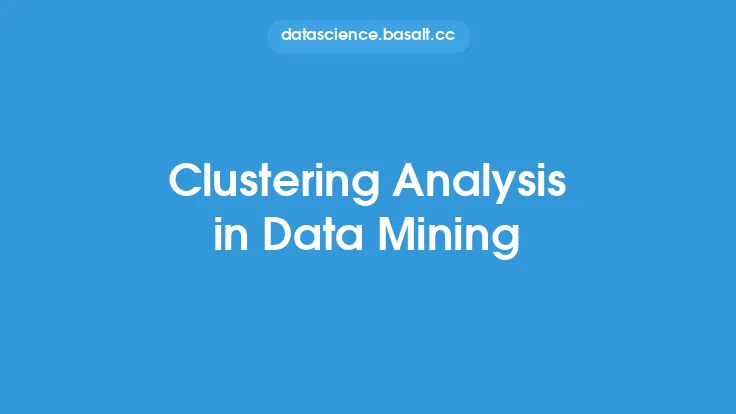Data mining is a process of discovering patterns, relationships, and insights from large sets of data, using various statistical and mathematical techniques. One of the key aspects of data mining is classification, which involves assigning a label or category to a set of data based on its characteristics. Classification techniques are widely used in data mining to predict customer behavior, identify trends, and make informed decisions. In this article, we will delve into the world of classification techniques in data mining, exploring the different types, algorithms, and applications.
Introduction to Classification Techniques
Classification techniques are a type of supervised learning, where the algorithm is trained on labeled data to predict the class or label of new, unseen data. The goal of classification is to assign a label or category to a set of data based on its characteristics, such as demographic information, behavior, or preferences. Classification techniques are used in a wide range of applications, including credit risk assessment, medical diagnosis, and customer segmentation. The key components of a classification technique include the data, the algorithm, and the evaluation metrics. The data consists of a set of features or attributes, which are used to train the algorithm. The algorithm is the mathematical formula or technique used to classify the data, and the evaluation metrics are used to measure the accuracy and performance of the algorithm.
Types of Classification Techniques
There are several types of classification techniques, including binary classification, multi-class classification, and multi-label classification. Binary classification involves assigning a label or category to a set of data based on two possible outcomes, such as 0 or 1, yes or no, or positive or negative. Multi-class classification involves assigning a label or category to a set of data based on multiple possible outcomes, such as different product categories or customer segments. Multi-label classification involves assigning multiple labels or categories to a set of data, such as assigning multiple product categories to a customer. Other types of classification techniques include hierarchical classification, which involves assigning labels or categories to a set of data based on a hierarchical structure, and ensemble classification, which involves combining multiple classification algorithms to improve accuracy and performance.
Classification Algorithms
There are several classification algorithms used in data mining, including logistic regression, decision trees, random forests, support vector machines, and k-nearest neighbors. Logistic regression is a statistical algorithm that uses a logistic function to predict the probability of a binary outcome. Decision trees are a type of algorithm that uses a tree-like structure to classify data based on a set of features or attributes. Random forests are an ensemble algorithm that combines multiple decision trees to improve accuracy and performance. Support vector machines are a type of algorithm that uses a hyperplane to separate data into different classes or categories. K-nearest neighbors is a type of algorithm that uses the k-nearest neighbors to a new data point to predict its class or label.
Evaluation Metrics for Classification Techniques
Evaluation metrics are used to measure the accuracy and performance of classification techniques. Common evaluation metrics include accuracy, precision, recall, F1 score, and area under the receiver operating characteristic (ROC) curve. Accuracy measures the proportion of correctly classified instances, while precision measures the proportion of true positives among all positive predictions. Recall measures the proportion of true positives among all actual positive instances, while F1 score measures the harmonic mean of precision and recall. The area under the ROC curve measures the ability of the algorithm to distinguish between positive and negative classes.
Applications of Classification Techniques
Classification techniques have a wide range of applications in data mining, including credit risk assessment, medical diagnosis, customer segmentation, and product recommendation. Credit risk assessment involves using classification techniques to predict the likelihood of a customer defaulting on a loan or credit card. Medical diagnosis involves using classification techniques to predict the likelihood of a patient having a particular disease or condition. Customer segmentation involves using classification techniques to assign customers to different segments based on their demographic information, behavior, or preferences. Product recommendation involves using classification techniques to recommend products to customers based on their past purchases or browsing history.
Challenges and Limitations of Classification Techniques
Despite the many applications and benefits of classification techniques, there are several challenges and limitations to consider. One of the main challenges is the issue of class imbalance, where one class or category has a significantly larger number of instances than the others. This can result in biased algorithms that favor the majority class. Another challenge is the issue of noise or missing data, which can affect the accuracy and performance of the algorithm. Additionally, classification techniques can be sensitive to the choice of algorithm and evaluation metrics, and may require significant computational resources and expertise to implement.
Future Directions for Classification Techniques
The field of classification techniques is constantly evolving, with new algorithms and techniques being developed to address the challenges and limitations of existing methods. One of the future directions for classification techniques is the use of deep learning algorithms, such as convolutional neural networks and recurrent neural networks, which have shown promising results in image and speech recognition tasks. Another future direction is the use of ensemble methods, which combine multiple classification algorithms to improve accuracy and performance. Additionally, there is a growing interest in the use of transfer learning and domain adaptation techniques, which enable the use of pre-trained models and algorithms on new, unseen data.
Best Practices for Implementing Classification Techniques
To implement classification techniques effectively, it is essential to follow best practices, such as collecting and preprocessing high-quality data, selecting the appropriate algorithm and evaluation metrics, and tuning hyperparameters to optimize performance. Additionally, it is essential to consider the interpretability and explainability of the algorithm, as well as the potential risks and biases associated with classification techniques. By following these best practices and staying up-to-date with the latest developments and advancements in the field, organizations can unlock the full potential of classification techniques and drive business value and insights from their data.





